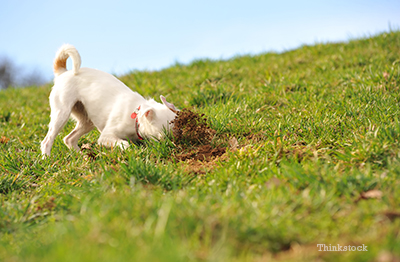
Sigh. Dogs will be dogs, won’t they? Unfortunately there’s no rhyme or reason to why your dog eats certain things, like used tissues or tampons from the bathroom trash (yes, they do it, and it’s disgusting), compost and even moldy kitchen garbage. Most of the time, this is due to the strange smells that tempt them, their curious nature and boredom.
The safest things you can do?
- Keep trash stored in closed pantry closets or out of reach
- Dump your trash frequently to avoid tempting your dog
- If you have a motivated Labrador retriever or chowhound, crate train your dog while you’re gone during the day to avoid an accidental poisoning.
- Make sure you have pet-proofed (or child-proofed) your house. While ingesting a used tissue isn’t directly harmful, we still want to minimize your dog’s chances of getting into things (some objects will get stuck in the stomach and intestines requiring emergency abdominal surgery).
Click here to learn about pet proofing your home.
What is it about eating dirt?
Once in a while, we’ll see dogs eating dirt. While dirt doesn’t get “stuck” in the stomach the way other foreign material can, this is still abnormal. However, if your dog eats dirt, this may be due to an underlying medical reason — not just a curious schnooze!
When animals eat unusual substances compulsively (such as dirt, kitty litter, gravel, etc.), we call this pica. In some species (e.g., horses), it’s often out of boredom. While pica can sometimes be associated with behavioral idiosyncrasies (like if you have a very bored dog), it’s often more likely due to anemia or rare iron or mineral deficiencies. As an emergency critical care veterinarian, I occasionally see pica due to severe, life-threatening anemia secondary to immune-mediated hemolytic anemia.
Likewise, if you are cooking a homemade diet or feeding your dog a frozen or raw food diet (Editor's Note: Ask your veterinarian before trying any new diet), make sure to get the diet assessed for trace mineral or vitamin deficiencies or excesses, as this can also result in pica.
So, if your dog is eating dirt, make sure to do the following:
- Check your dog’s gum color to make sure that his gums don’t appear too pale or jaundiced – if they do, an immediate veterinary visit is a must!
- Check the diet – if it’s an AAFCO balanced diet, it’s unlikely that there is a vitamin or mineral deficiency. However, if it’s a homemade food, consider consulting with a veterinary nutritionalist. The American College of Veterinary Nutrition offers a list here.
- Visit your veterinarian for blood work or x-rays, especially if you notice other signs of lethargy, decreased appetite, or weight loss. The sooner a medical problem is identified, the sooner we can treat it and often the better (and less expensive) the outcome!
- If your dog is doing great, eating well and not showing any clinical signs, add in some environmental enrichment instead. Prevent your dog from eating the dirt, and offer him a treat like a Buster Ball filled with his favorite canned food instead – it’ll provide hours of fun as he tries to work the food out.
When in doubt, talk to your veterinarian about this unusual – but potentially medical – cause for eating dirt!
If you have any questions or concerns, you should always visit or call your veterinarian -- they are your best resource to ensure the health and well-being of your pets.
